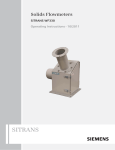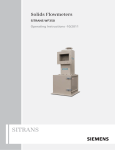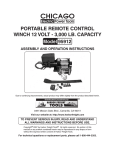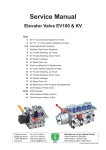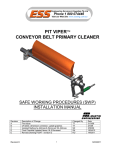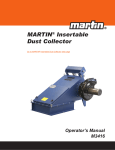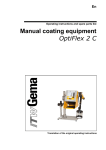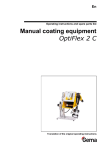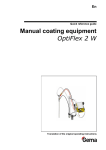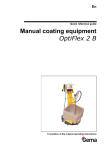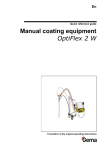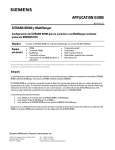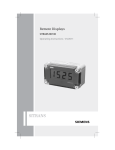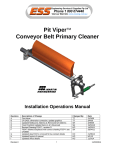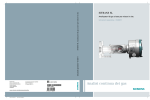Download SITRANS WF340 - Lesman Instrument Company
Transcript
Solids Flowmeters SITRANS WF340 Operating Instructions 10/2011 SITRANS Safety Guidelines Warning notices must be observed to ensure personal safety as well as that of others, and to protect the product and the connected equipment. These warning notices are accompanied by a clarification of the level of caution to be observed. Qualified Personnel This device/system may only be set up and operated in conjunction with this manual. Qualified personnel are only authorized to install and operate this equipment in accordance with established safety practices and standards. Unit Repair and Excluded Liability: The user is responsible for all changes and repairs made to the device by the user or the user’s agent. All new components are to be provided by Siemens Milltronics Process Instruments. Restrict repair to faulty components only. Do not reuse faulty components. Warning: Cardboard shipping package provides limited humidity and moisture protection. This product can only function properly and safely if it is correctly transported, stored, installed, set up, operated, and maintained. This product is intended for use in industrial areas. Operation of this equipment in a residential area may cause interference to several frequency based communications. Note: Always use product in accordance with specifications. Copyright Siemens AG 2011. All Rights Reserved Disclaimer of Liability This document is available in bound version and in electronic version. We encourage users to purchase authorized bound manuals, or to view electronic versions as designed and authored by Siemens Milltronics Process Instruments. Siemens Milltronics Process Instruments will not be responsible for the contents of partial or whole reproductions of either bound or electronic versions. While we have verified the contents of this manual for agreement with the instrumentation described, variations remain possible. Thus we cannot guarantee full agreement. The contents of this manual are regularly reviewed and corrections are included in subsequent editions. We welcome all suggestions for improvement. Technical data subject to change. MILLTRONICS®is a registered trademark of Siemens Milltronics Process Instruments. Contact SMPI Technical Publications at the following address: European Authorized Representative Technical Publications Siemens AG Siemens Milltronics Process Instruments 1954 Technology Drive, P.O. Box 4225 Peterborough, Ontario, Canada, K9J 7B1 Email: [email protected] Siemens AG Industry Sector 76181 Karlsruhe Deutschland For a selection of Siemens Milltronics level measurement manuals, go to: www. siemens.com/processautomation. Under Process Instrumentation, select Level Measurement and then go to the manual archive listed under the product family. For a selection of Siemens Milltronics weighing manuals, go to: www. siemens.com/processautomation. Under Weighing Technology, select Continuous Weighing Systems and then go to the manual archive listed under the product family. © Siemens AG 2011 SITRANS WF340 1 ___________________ Introduction 2 ___________________ Safety notes SITRANS Solids Flowmeters SITRANS WF340 3 ___________________ Description 4 ___________________ Installing/mounting 5 ___________________ Service and maintenance 6 ___________________ Technical data Operating Instructions 7 ___________________ Dimension drawings 8 ___________________ Application examples 10/2011 7ML19985CU02-00 Legal information Legal information Warning notice system This manual contains notices you have to observe in order to ensure your personal safety, as well as to prevent damage to property. The notices referring to your personal safety are highlighted in the manual by a safety alert symbol, notices referring only to property damage have no safety alert symbol. These notices shown below are graded according to the degree of danger. DANGER indicates that death or severe personal injury will result if proper precautions are not taken. WARNING indicates that death or severe personal injury may result if proper precautions are not taken. CAUTION with a safety alert symbol, indicates that minor personal injury can result if proper precautions are not taken. CAUTION without a safety alert symbol, indicates that property damage can result if proper precautions are not taken. NOTICE indicates that an unintended result or situation can occur if the relevant information is not taken into account. If more than one degree of danger is present, the warning notice representing the highest degree of danger will be used. A notice warning of injury to persons with a safety alert symbol may also include a warning relating to property damage. Qualified Personnel The product/system described in this documentation may be operated only by personnel qualified for the specific task in accordance with the relevant documentation, in particular its warning notices and safety instructions. Qualified personnel are those who, based on their training and experience, are capable of identifying risks and avoiding potential hazards when working with these products/systems. Proper use of Siemens products Note the following: WARNING Siemens products may only be used for the applications described in the catalog and in the relevant technical documentation. If products and components from other manufacturers are used, these must be recommended or approved by Siemens. Proper transport, storage, installation, assembly, commissioning, operation and maintenance are required to ensure that the products operate safely and without any problems. The permissible ambient conditions must be complied with. The information in the relevant documentation must be observed. Trademarks All names identified by ® are registered trademarks of Siemens AG. The remaining trademarks in this publication may be trademarks whose use by third parties for their own purposes could violate the rights of the owner. Disclaimer of Liability We have reviewed the contents of this publication to ensure consistency with the hardware and software described. Since variance cannot be precluded entirely, we cannot guarantee full consistency. However, the information in this publication is reviewed regularly and any necessary corrections are included in subsequent editions. Siemens AG Industry Sector Postfach 48 48 90026 NÜRNBERG GERMANY Order number: 7ML19985CU02 Ⓟ 09/2011 Copyright © Siemens AG 2011. Technical data subject to change Table of contents 1 Introduction................................................................................................................................................ 5 1.1 2 Safety notes............................................................................................................................................... 7 2.1 3 6 8 Location........................................................................................................................................11 Service and maintenance ........................................................................................................................ 13 5.1 Maintenance.................................................................................................................................13 5.2 Technical support.........................................................................................................................13 Technical data ......................................................................................................................................... 15 6.1 7 SITRANS WF340...........................................................................................................................9 Installing/mounting................................................................................................................................... 11 4.1 5 General safety instructions ............................................................................................................7 Description................................................................................................................................................. 9 3.1 4 The manual ....................................................................................................................................5 Specifications ...............................................................................................................................15 Dimension drawings ................................................................................................................................ 17 7.1 SITRANS WF340 40 t/h version - outline and mounting .............................................................17 7.2 SITRANS WF340 300 t/h version - outline and mounting ...........................................................20 Application examples............................................................................................................................... 23 8.1 Materials.......................................................................................................................................23 8.2 Material feed ................................................................................................................................24 8.3 Flowmeter in-feed chutes.............................................................................................................26 8.4 Flowguide capacity ......................................................................................................................31 SITRANS WF340 Operating Instructions, 10/2011, 7ML19985CU02-00 3 Table of contents SITRANS WF340 4 Operating Instructions, 10/2011, 7ML19985CU02-00 Introduction 1 Note The Siemens solids flowmeter is to be used only in the manner outlined in this manual, otherwise protection provided by equipment may be impaired. It is your responsibility to read this manual before installing and starting up any component of the weighing system to which the flowmeter is being applied. NOTICE For industrial use only This product is intended for use in industrial areas. Operation of this equipment in a residential area may cause interference to several frequency based communications. 1.1 The manual This manual covers only flowmeter installation, operation, and maintenance procedures. Sensing head and integrator instruction manuals are available for download from our web site: Siemens weighing (http://www.siemens.com/weighing) Follow these operating instructions for quick, trouble-free installation, and maximum accuracy and reliability of your weighing system. We always welcome suggestions and comments about manual content, design, and accessibility. Please direct your comments to: Technical publications (mailto:[email protected]) SITRANS WF340 Operating Instructions, 10/2011, 7ML19985CU02-00 5 Introduction 1.1 The manual SITRANS WF340 6 Operating Instructions, 10/2011, 7ML19985CU02-00 2 Safety notes 2.1 General safety instructions CAUTION Correct, reliable operation of the product requires proper transport, storage, positioning and assembly as well as careful operation and maintenance. Only qualified personnel should install or operate this instrument. Note Alterations to the product, including opening or improper repairs of the product, are not permitted. If this requirement is not observed, the CE mark and the manufacturer's warranty will expire. SITRANS WF340 Operating Instructions, 10/2011, 7ML19985CU02-00 7 Safety notes 2.1 General safety instructions SITRANS WF340 8 Operating Instructions, 10/2011, 7ML19985CU02-00 3 Description 3.1 SITRANS WF340 SITRANS WF340 solids flowmeters are compact vertical, low- to medium-capacity flowmeters for various product sizes, densities and fluidities, particularly fine powders. The 40 t/h version, combined with a SITRANS WFS300 sensing head, is suitable for material flowrates up to 40 t/h (44 STPH). The 300 t/h version with a SITRANS WFS320 sensing head is suitable for up to 300 t/h (330 STPH). ① ② ③ Material feed Flowguide Sensing plate ④ ⑤ ⑥ Impact force Housing Material discharge The flowmeter sensing head LVDT output signal is processed by the integrator (ordered separately) to: ● monitor material flow ● maintain accurate material inventory ● provide batch control for process or loadout purposes1 ● control the ratio of materials in continuous blending processes1 1additional equipment required SITRANS WF340 Operating Instructions, 10/2011, 7ML19985CU02-00 9 Description 3.1 SITRANS WF340 " " " " " A B A+B System components Components of the SITRANS WF340 solids flowmeter system include: ● SITRANS WF340 flowmeter housing and flowguide ● SITRANS WFS300 or WFS320 sensing head (ordered separately) ● stainless steel sensing plate (ordered separately) ● electronic flowmeter integrator (ordered separately) SITRANS WF340 10 Operating Instructions, 10/2011, 7ML19985CU02-00 Installing/mounting 4.1 4 Location Install SITRANS WF340 in an area that is suitable for the system approval rating. Position the flowmeter to permit opening the sensing plate housing door for sensing plate access, and removing the sensing head rear cover for calibration purposes. Ensure the flowmeter inlet and outlet mounting points are free from vibration. If vibration is expected, use a base mounted sensing head if using the 40 t/h version of WF340. 1. Position the flowmeter into the desired location. 2. If necessary, shim the housing base to level. 3. Fasten the housing discharge to the downstream material chute. 4. Fasten the flowguide to the material infeed chute. 5. Refer to SITRANS WFS300 or WFS320 operating instructions for sensing head installation, levelling, sensing plate installation, and integrator interconnection instructions. Note Provide sufficient mechanical support for the flowmeter and chutework. Note To prevent accidental damage, temporarily remove the sensing head (side mount versions only) if the flowmeter cannot be easily positioned. SITRANS WF340 Operating Instructions, 10/2011, 7ML19985CU02-00 11 Installing/mounting 4.1 Location SITRANS WF340 12 Operating Instructions, 10/2011, 7ML19985CU02-00 Service and maintenance 5.1 5 Maintenance If material sticks to the sensing plate, incorporate a program to ensure that the impingement area remains clean. If sticking persists, contact your Siemens representative. Check for wearing of the sensing plate. If wear is excessive, contact your Siemens representative. Unit repair and excluded liability All changes and repairs must be done by qualified personnel and applicable safety regulations must be followed. Please note the following: ● The user is responsible for all changes and repairs made to the device. ● All new components must be provided by Siemens. ● Restrict repair to faulty components only. ● Do not re-use faulty components. 5.2 Technical support If you have any technical questions about the device described in these Operating Instructions and do not find the right answers, you can contact Customer Support: ● Via the Internet using the Support Request: Support request (http://www.siemens.com/automation/support-request) ● Via Phone: – Europe: +49 (0)911 895 7222 – America: +1 423 262 5710 – Asia-Pacific: +86 10 6475 7575 Further information about our technical support is available on the Internet at Technical support (http://support.automation.siemens.com/WW/view/en/16604318) SITRANS WF340 Operating Instructions, 10/2011, 7ML19985CU02-00 13 Service and maintenance 5.2 Technical support Service & Support on the Internet In addition to our documentation, we offer a comprehensive knowledge base online on the Internet at: Service & Support (http://www.siemens.com/automation/service&support) There you will find: ● The latest product information, FAQs, downloads, tips and tricks. ● Our newsletter, providing you with the latest information about your products. ● Our bulletin board, where users and specialists share their knowledge worldwide. ● You can find your local contact partner for Industry Automation and Drives Technologies in our partner database. ● Information about field service, repairs, spare parts and lots more under "Services." Additional Support Please contact your local Siemens representative and offices if you have additional questions about the device Find your contact partner at: Local contact person (http://www.siemens.com/automation/partner) SITRANS WF340 14 Operating Instructions, 10/2011, 7ML19985CU02-00 6 Technical data 6.1 Specifications Model 40 t/h version 300 t/h version Product 40 t/h version fine powder up to 13 mm (0.5") 300 t/h version fine powder up to 25 mm (1") Product temperature -40 to +232 °C (-40 to +450 °F) Ambient temperature -40 to +60 °C (-40 to +140 °F) Accuracy ±1 %, 33 to 100 % of design capacity; extended accuracy range with linearization function of integrator Accuracy subject to: on factory approved installations the flowmeter system’s totalized weight will be within the specified accuracy when compared to a known weighed material test sample. The test rate must be within the specified range of the design capacity and held constant for the duration of the test. The minimum material test sample must be equivalent to a sample obtained at the test flow rate for at least ten minutes running time. SITRANS WF340 Operating Instructions, 10/2011, 7ML19985CU02-00 15 Technical data 6.1 Specifications Repeatability ±0.2 % Capacity range 40 t/h version 0.2 to 40 t/h (0.2 to 44 STPH) 300 t/h version 20 to 300 t/h (22 to 330 STPH) Construction painted mild steel flowguide and sensing plate housing and AISI 304 (1.4306) stainless steel sensing plate optional special materials and coatings for flowguide and sensing plate Approvals General CE, C-TICK Stainless steel options meet FDA and USDA requirements for food processing. SITRANS WF340 16 Operating Instructions, 10/2011, 7ML19985CU02-00 Dimension drawings 7.1 7 SITRANS WF340 40 t/h version - outline and mounting SITRANS WF340 Operating Instructions, 10/2011, 7ML19985CU02-00 17 C C C Figure 7-1 ( & $ C % ' ) * Dimension drawings 7.1 SITRANS WF340 40 t/h version - outline and mounting SITRANS WF340, 40 t/h version. Dimensions in mm (in) SITRANS WF340 18 Operating Instructions, 10/2011, 7ML19985CU02-00 Dimension drawings 7.1 SITRANS WF340 40 t/h version - outline and mounting ① Minimum allowance for sensing head installation ⑥ Minimum allowance for sensing plate installation ② Flowguide ⑦ Access and bolt holes to suit sensing head ③ ④ ⑤ Housing ⑧ ⑨ ⑩ Discharge center line Access door Sensing head center line Sensing head center line 20 holes Size A B C D E F G 1 76 (3) 152 (6) 184 (7.25) 260 (10.25) 8 111 (4.38) 73 (2.88) 2 102 (4) 254 (10) 210 (8.25) 362 (14.25) 10 108 (4.25) 86 (3.38) 3 127 (5) 305 (12) 235 (9.25) 413 (16.25) 12 94 (3.69) 99 (3.88) Dimensions in mm (in) Note - Mild steel or stainless construction. - Sensing head support should be rigid and independent of housing. SITRANS WF340 Operating Instructions, 10/2011, 7ML19985CU02-00 19 Dimension drawings 7.2 SITRANS WF340 300 t/h version - outline and mounting SITRANS WF340 300 t/h version - outline and mounting 1 C $ & ( + ' C % * , . C - C 0 / 0 - / . 7.2 SITRANS WF340 20 Operating Instructions, 10/2011, 7ML19985CU02-00 Dimension drawings 7.2 SITRANS WF340 300 t/h version - outline and mounting Figure 7-2 SITRANS WF340, 300 t/h version. Dimensions in mm (in) ① Minimum allowance for sensing head installation ⑥ Sensing head center line ② Flowguide center line ⑦ Minimum allowance for sensing plate installation ③ Flowguide ⑧ Access and bolt holes to suit sensing head ④ ⑤ Housing ⑨ ⑩ Flowguide center line Access door Sensing head center line Size A B C D E F G H I J K L M N 1 127 (5) 406 (16) 235 (9.25) 515 (20.25) 12 118 (4.63) 95 (3.75) 308 (12.12) 330 (13) 616 (24.25) 718 (28.25) 17 (0.69) 137 (5.38) 20 2 152 (6) 508 (20) 260 616 (10.25) (24.25) 14 114 (4.5) 108 (4.25) 359 (14.12) 381 (15) 718 (28.25) 819 (32.25) 19 (0.75) 130 (5.125) 24 Dimensions in mm (in) Note - Mild steel or stainless construction. - Sensing head support should be rigid and independent of housing. SITRANS WF340 Operating Instructions, 10/2011, 7ML19985CU02-00 21 Dimension drawings 7.2 SITRANS WF340 300 t/h version - outline and mounting SITRANS WF340 22 Operating Instructions, 10/2011, 7ML19985CU02-00 Application examples 8 Note For best performance and limited maintenance requirements, keep in mind material compatibility and flow patterns. 8.1 Materials Material characteristics for best results: ● low cohesion (flows well through chutes, like a liquid) ● low adhesion (does not stick to surfaces) ● low abrasion (will not wear out chutes, flowguide, or sensing plate) ● low causticity (will not damage internal flowmeter components) Most materials with low moisture content have excellent flow and adhesion characteristics. In processes where material moisture content varies, select a flowmeter location where the moisture content is lowest. Use sensing plate and flowguide non-stick linings for ammonium nitrate, cocoa, fertilizer, wheat flour, gluten, laundry detergent, sugar, and other materials with similar properties. Abrasive materials are best monitored at low velocity. Use sensing plate and flowguide abrasion resistant linings for alumina, asbestos, barley, carbide, corn, clinker, limestone, perlite ore, and other materials with similar hardness, and particle mass. Standard flowmeter components are resistant to chemical reaction with most materials. Use special paint or coatings on exposed flowmeter components for ammonium nitrate, carbide, fertilizer, phosphate, salt, sodium chloride, sodium sulphate, and other materials with similar properties. SITRANS WF340 Operating Instructions, 10/2011, 7ML19985CU02-00 23 Application examples 8.2 Material feed 8.2 Material feed Ideal material infeed characteristics: ● constant and relatively low material velocity ● uniform material flowrate (not pulsing) ● negligible air flow through the flowmeter ● flowguide 17 to 70 % full during operation For best results, use material from an elevated bin, gravity fed to the flowmeter. If the material is to be monitored after some process has been performed, choose the feeder device that provides the most consistent material flow. Use a reverse flowguide transition when high or variable velocity feeder material discharges are anticipated. Refer to Flowmeter in-feed chutes (Page 26). Position the flowmeter discharge chute so material cannot back up into the flowmeter housing. Use a heavier flowmeter sensing head range spring and/or viscous damper fluid to compensate for slight to moderate material pulsing at greater than 1 pulse per second. For heavily pulsing feeder discharges, at less than 1 pulse per second, consult your local Siemens representative. Screw conveyor ① short pitch ② double flight most common type of material feeder short pitch and/or double flight screws preferred to reduce the batch size (and increase the frequency) of the material discharge pulse, or cut back the flights of a standard screw so it ends before the discharge opening use reverse flowguide transition for variable operating speeds or constant speeds above 40 rpm Rotary feeder provides an air seal between the upstream and/or downstream process, and the flowmeter required if the material is pneumatically conveyed or flowmeter/process isolation is required use reverse flowguide transition for variable operating speeds or constant speeds above 10 rpm SITRANS WF340 24 Operating Instructions, 10/2011, 7ML19985CU02-00 Application examples 8.2 Material feed Bucket elevators commonly used for grain applications feeder discharge damping required when slow elevators (typically chain drive) produce heavily pulsing material discharge use deadbox if required to reduce material velocity from fast elevators (typically re-inforced belt drive) Conveyor belt ① material discharge baffle produces a non-pulsing material discharge reverse flowguide transition (and/or material discharge baffle) often required for variable belt speeds or constant speeds in excess of 1 m/s (200 feet/minute) Drag conveyor operates at a constant (and relatively low) velocity reverse flowguide transition not normally required but use feeder discharge damping or a discharge baffle to minimize the pulsing material discharge SITRANS WF340 Operating Instructions, 10/2011, 7ML19985CU02-00 25 Application examples 8.3 Flowmeter in-feed chutes Vibratory feeder produces a non-pulsing material discharge use reverse flowguide transition for variable speed varieties ① motor ② vibrating pan 8.3 Flowmeter in-feed chutes Flowmeter in-feed chutes The flowmeter in-feed chute delivers the material from the bin or feeder discharge to the flowmeter flowguide. The ideal in-feed chute pre-conditions the material flow to minimize the effect of abrasion, velocity variation, feeder discharge trajectory variation, and pulsing. Feeder/flowguide transition reverse flowguide transition reverses direction of the bin or feeder material discharge before the material enters the flowmeter flowguide reversing direction forces the material into a desirable flow pattern rather than permitting material to be flung from the feeder, directly into the flowguide transition is especially important for high or variable speed feeders SITRANS WF340 26 Operating Instructions, 10/2011, 7ML19985CU02-00 Application examples 8.3 Flowmeter in-feed chutes forward flowguide transition maintains the material in the same direction between the bin or feeder discharge and the flowmeter flowguide transition is acceptable for a low and constant velocity feeder if a forward flowguide transition must be used for a high or variable speed feeder application, install a baffle plate ① baffle plate Short fall chute material in-feed chute where the bin or feeder discharge to flowmeter flowguide fall is less than 0.6 m (2 ft) material velocity due to gravity minimized chute centreline and angle should coincide with that of the flowguide, for a distance greater than or equal to the flowguide diameter (before the flowguide inlet) ① < 0.6 m (2 ft) SITRANS WF340 Operating Instructions, 10/2011, 7ML19985CU02-00 27 Application examples 8.3 Flowmeter in-feed chutes Long fall chute material in-feed where the bin or feeder discharge/flowguide fall is more than 0.6 m (2 ft) less desirable than the short fall chute because material velocity is greater, increasing flowmeter component abrasion greater distances after chute angle changes required to settle material into desirable flow patterns ① > 0.6 m (2 ft) Dogleg used to reduce the detrimental effect of high or variable material velocity, especially when using a long fall chute for abrasive materials, line the chute with an abrasion resistant material, or use an in-feed deadbox Deadbox installed where the chute angle changes. This will cause the material to impact upon itself, rather than the chute surface. used when the feeder discharge velocity is high, variable, where long fall chute angles change, and if the material is particularly abrasive SITRANS WF340 28 Operating Instructions, 10/2011, 7ML19985CU02-00 Application examples 8.3 Flowmeter in-feed chutes Pulsing feeder discharge damping install a temporary holding bin to receive pulsing material discharge from a feeder. Then the material is gravity fed from the bin to the flowmeter flowguide. provide manual or automatic control to ensure the holding bin is neither emptied nor overfilled while the feeder is in operation. bin could also be used for the integrator on-line calibration, (if so equipped). Refer to the integrator instruction manual for bin requirements. for drag conveyors, use a baffle plate installed at the conveyor discharge to reduce the heavy material pulsing associated with this type of feeder Top view ① baffle ② conveyor discharge ③ slats In-feed/discharge air pressure Vent the in-feed and discharge chutes to a common dust collector if a material in-feed/discharge differential air pressure is anticipated and rotary airlock feeders are not used. A tuning gate can be installed in each vent to balance the air pressure. If a dust collector is not used, an air bypass chute can be installed between the flowmeter in-feed and discharge chutes. ① to common dust collector SITRANS WF340 Operating Instructions, 10/2011, 7ML19985CU02-00 29 Application examples 8.3 Flowmeter in-feed chutes In-feed/discharge air pressure when a material in-feed/discharge differential air pressure is anticipated, and rotary airlock feeders are not utilized, vent the in-feed and discharge chutes to a common dust collector install a tuning gate in each vent to balance the air pressure if a dust collector is not used, install an air bypass chute between the flowmeter in-feed and discharge chutes ① to common dust collector SITRANS WF340 30 Operating Instructions, 10/2011, 7ML19985CU02-00 Application examples 8.4 Flowguide capacity 8.4 Flowguide capacity Flowguide capacity Refer to the following chart, to ensure the flowguide capacity is suitable. Flowguide Capacity Chart 160 2.56 140 2.24 120 1.92 4x10 5x16 1.60 100 Bulk density lb/ft³ 3x6 5x12 6x20 80 1.28 60 0.96 40 0.64 20 0.32 Bulk density t/m³ 0 0 1 10 100 400 Flowrate in tons per hour Note If the material bulk density and flowrate is near a flowguide diameter upper limit, choose the next larger flowguide size. SITRANS WF340 Operating Instructions, 10/2011, 7ML19985CU02-00 31 Application examples 8.4 Flowguide capacity SITRANS WF340 32 Operating Instructions, 10/2011, 7ML19985CU02-00 www.siemens.com/processautomation For more information www.siemens.com/level www.siemens.com/weighing Siemens AG Subject to change without prior notice Industry Sector 7ML19985CU02 Rev. 2.0 1954 Technology Drive © Siemens AG 2011 P.O. Box 4225 Peterborough, ON Canada K9J 7B1 email: [email protected] www.siemens.com/processautomation *7ml19985CU02* Printed in Canada



































